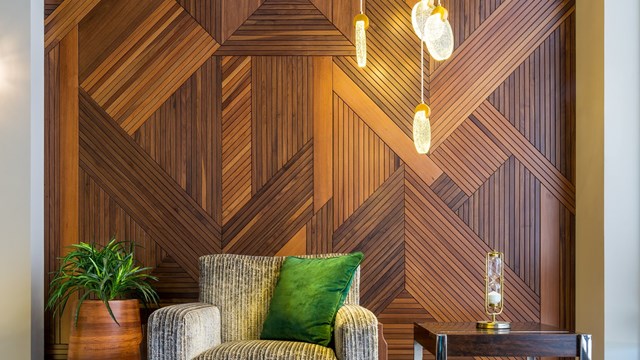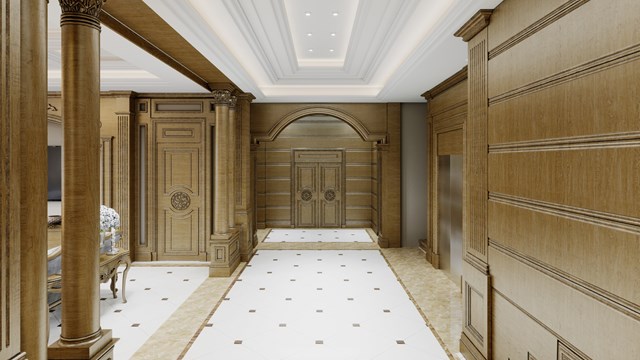Taste is subjective. Luckily your board’s design rules and guidelines aren’t. From gaudy exterior paint colors, to improperly mounted flagpoles, to Clark Griswold-esque holiday light displays, the exterior design choices of individual unit owners can negatively impact the quality of life and the property values of the entire community. But how can a board maintain control of community aesthetics without trampling on the goodwill and legally protected rights of the community’s owners?
Design Rules
Most board members are working from design rules and restrictions inherited from developers or a previous generation of leadership. “Developers put these architectural rules in place because during the period of buildout and sale, they want to ensure that there's consistency and uniformity in the community because it looks better on the marketing brochure,” explains Tom Skiba, the chief executive officer of the Community Associations Institute (CAI), an international organization of 60 chapters dedicated to providing educational and resource information to community associations and HOAs worldwide. The New Jersey chapter of CAI (CAI-NJ) is in Freehold, and there is a Southern New Jersey, Pennsylvania and Delaware Valley chapter (CAI-PADELVAL) in King of Prussia, PA.
In fact, many potential owners are drawn to these communities because of the uniformity presented in those brochures. That uniformity works great, notes Skiba, “as long as there's a mechanism in the governing documents that allows the community to evolve once it passes from developer control to owner control, and as the nature of the community and its residents changes over time.”
For example, you might have a community that gets started with an initial group of owners that tends to skew older—maybe their kids are out of the house, and then 15-20 years down the road—the next generation of owners moves in and now the community consists of families with young children.
Tot lots and playgrounds weren't a big deal 20 years ago, but suddenly it's potentially an area of conversation. “That's also true with architectural standards,” says Skiba. “Things evolve. If you live in Scottsdale, AZ, do you want your community to basically be the same beige as every other community or do you want to do some things that make it distinct? That's the essence of the community association model. It's up to the residents through their board to have that conversation and make a decision that's beneficial to and bought into by the entire community.”
Protecting Your Investment
In the battle between conformity and individual expression, Phyllis Beres, a community manager in North Brunswick for FirstService Residential Mid-Atlantic, says boards have to consider the bottom line for the sake of the association as a whole. “I do feel that it is the board’s fiduciary responsibility to protect the owner’s investments by enforcing these rules and regulations because it does maintain property value, which is the goal,” says Beres. “Communities that do have a lot of rules and regulations that are enforced, it’s protecting the unit owners’ investment. When we communicate with unit owners, it’s not just, ‘Here's the rule,’ it’s, ‘Here’s the rule and why.’” If someone is heartbroken they can’t display their family of plastic flamingos, the board might want to gently explain that the decoration does not help with curb appeal.
What's most important is that the evolution of the community's design standards happens through the proper processes put in place in the governing documents. “The most well-run communities take as step back every eight, ten, or twelve years and review the rules they've had in place for the past decade,” Skiba says. “Do they make sense? Should we change them?” Skiba recommends soliciting ideas and opinions from owners, and looking around at what's happening in the community's region in order to ensure that the community remains attractive so the property values remain at the highest level.
Often, it’s not having too many rules that irritates residents, it’s observing rules be unequally enforced, or a lack of understanding on why the rule exists. “You want to enforce rules fairly, provide guidelines, and inundate them with information so there’s no question what the board’s motivation is, where the money’s going. You have associations that have regulations for various items and they just fine, fine, fine, and they don’t want to correct the behavior, they just want to fine, they don’t communicate with the owners,” says Beres.
More Than Just Looks
Design rules aren't just about aesthetics; they're also about liability. “If you're making changes on a common element, like a shared hallway, rooftop, or courtyard, then you're doing work on property you don't actually own,” says Skiba. Take, for instance, a case in which an owner installed a flagpole to hang the American flag and the United States Marine Corps flag while her son was deployed overseas. “The issue wasn't the the flags, but the fact that she'd built a twenty-foot flagpole on property she didn't own,” says Skiba. “Now, suddenly the community is liable for any damage that it would've done to anyone if it were to fall or if it weren't property installed. Changing common property is well beyond the simple architectural design decision of what's allowed for an individual in a condo or co-op to do regarding common property; it's got much more depth to it than just the design aspect.” The American flag is legally allowed to be displayed based on federal legislation passed in 2006 but boards have a right to control placement and aesthetics. In the case of the flagpole, the owner was responsible for taking it down and relocating it to an area that was actually controlled and owned by the owner.
Similar to the flagpole issue is the installation of satellite dishes on the roof of a building rather than on a limited common element, like a balcony. “You can't allow an owner to do a DIY installation of their satellite dish on a shared roof,” says Skiba. “Most condominiums, if they allow it, will say it has to be done by an insured and bonded installer. The last thing a board needs it somebody punching a hole in the roof and causing a leak. There are so many downstream issues that arise.”
In these cases where an owner is making an unapproved change or installation on shared property, or even if they're painting the outside of their unit a color outside of the approved palate, it's important that the board act quickly.
“Hopefully you get to them before the job is complete, at which point you can stop them and let them know that they may not want to move forward and spend a lot of money when they're going to end up having to change it back or change it to something compliant,” according to Skiba. “If the work is already done, then depending on your governing documents, the board may have the right to fine the owner until they rectify the situation. In other cases, the board may use it as a jumping off point for a larger conversation, to say that maybe this change is a change we should be willing to allow, or that maybe it's time for a change in the rules.”
In a worst-case scenario, the board will go to court to get a judgment against the owner that says the owner must undo their work or change it to something compliant. “Hopefully the board can prevent the situation from snowballing to the point where they're in court arguing in front of a judge,” says Skiba.
Freedom of Expression
But what about less-permanent design issues, such as holiday decorations or political signage? Does a board's attempt to regulate this type of religious or political décor infringe on an owner's first amendment rights? “The reality is, particularly when you get to constitutional issues related to free speech, the courts have historically and consistently said that community associations are not government entities,” says Skiba. “The U.S. Constitution and the state constitutions state that the government cannot limit free speech. Since owners freely entered into a contract with their association, which is not a governmental entity, they've agreed to these limitations when they signed that contract.”
The rules for this type of décor work best when they are specific and reasonable. “Maybe for holiday decorations, you have a rule that they're not up before Thanksgiving and are taken down before the middle of January,” notes Skiba. “And the rules should indicate that they apply to decorative or holiday lights that are visible from outside the unit, so that whether they're hung outside or inside a window is irrelevant.” As another presidential election approaches, the board should be aware of their restrictions on political signage so that they can regulate displays as needed.
J. David Ramsey, a shareholder attorney at the law firm of Becker & Poliakoff in Morristown, says New Jersey happens to be on the leading edge of protecting political speech outside government contexts. The state court decisions vary a bit from HOAs and condos. “Take the HOA situation. Now the guy owns his own lot, and he wants to put up a sign “Vote for Trump.” The New Jersey courts say you can put reasonable time, manner, and place restrictions on that signage, even on somebody’s own lot, but you cannot prohibit it,” says Ramsey. You can say all political signs can only be up within two weeks of the election, but you can’t say they can never be up. Not in New Jersey.
Be Fair
In regards to enforcing the rules that have been put in place, it's essential that the board be fair in how the rules are enforced. The board has a legal obligation to enforce the rules for all owners; they have no flexibility to enforce the rules for some owners but not for others. “If a board shows preferential treatment to one owner, or denies someone's architectural request but approves the same request for someone else because they're friends with a board member, for example, that inequity would make them negligent as board members,” says Skiba.
“That's something a lot of owners don't get. They think that the board invented the rules and covenants of the community, and then they just enforce the ones they want to enforce. For most board members, the rules were in place before they were elected, and they'll continue to be in place when that board member leaves. While they're on the board, they have a legal obligation to enforce those rules. All of attorney's will tell you the same thing: the thing that gets a board in trouble is if they enforce rules in an arbitrary and capricious manner. It's the worst thing a board can do.”
Jenn Welch is a staff writer at The Cooperator. Associate Editor Tom Lisi contributed to this article.










Leave a Comment